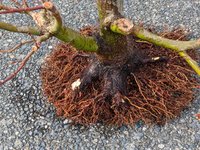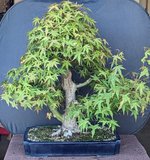0soyoung
Imperial Masterpiece
This (UR2) is the acer palmatum air layer clone that I used for the thread Regarding Wound Healing. In the end of my postings to that thread, I showed a slanted cut chop that eliminated one of the two apical branches. I made that choice because I decided that this view, in which the chop is on the backside, had to be the front. I took this photo shortly after leaf fall 2015

and used a Photoshop-like program (Paint.net) to make virtual images to decide what to do with it (my abilities to sketch are quite sketchy). I came up with these three ideas:
1 2
2

3
In all of them, l eliminated that branch on the left side of the third node – I don’t like that bar (branching) in any circumstance. There is one other feature of this tree that I don’t deal with in those virtuals and it is that there is no branch anywhere in back.
The third idea is the one I decided to pursue. I think it is an interesting hybrid of the other two, more conventional, design ideas. Moreover, I think it is safest choice in the sense that either of the other two options is always possible by simply lopping off branches at any future date. At least it effectively will be with my ‘solution’ for the no-branches-in-back problem.
Referring to the first pic (above), the apical shoot going out the top of the photo is a 3+foot long forked whip that I noted could be used for grafting, so l bent it around and tied it to the trunk into a position near the third internode last December. My (hopeful) solution is to approach graft one fork on the right-rear side of the third internode that runs backward and to the left (instead of sideways to the left as shown in idea#2). After this season, I can decide about whether to steer this branch to be directly behind the trunk or into a position more akin to idea#2.
I think the branch coming almost directly forward from the second node needs to be thickened considerably, as well as steered hard to the right. I decided to approach graft the other fork of the whip to be that next right-going leg, thinking that it might save a season’s time over pruning and praying for a bud to pop in the right place next year.
So, snip, snip, saw, cut, (%##%&^*), twist, zip, etc.,
Voila!


and used a Photoshop-like program (Paint.net) to make virtual images to decide what to do with it (my abilities to sketch are quite sketchy). I came up with these three ideas:
1
 2
2

3

In all of them, l eliminated that branch on the left side of the third node – I don’t like that bar (branching) in any circumstance. There is one other feature of this tree that I don’t deal with in those virtuals and it is that there is no branch anywhere in back.
The third idea is the one I decided to pursue. I think it is an interesting hybrid of the other two, more conventional, design ideas. Moreover, I think it is safest choice in the sense that either of the other two options is always possible by simply lopping off branches at any future date. At least it effectively will be with my ‘solution’ for the no-branches-in-back problem.
Referring to the first pic (above), the apical shoot going out the top of the photo is a 3+foot long forked whip that I noted could be used for grafting, so l bent it around and tied it to the trunk into a position near the third internode last December. My (hopeful) solution is to approach graft one fork on the right-rear side of the third internode that runs backward and to the left (instead of sideways to the left as shown in idea#2). After this season, I can decide about whether to steer this branch to be directly behind the trunk or into a position more akin to idea#2.
I think the branch coming almost directly forward from the second node needs to be thickened considerably, as well as steered hard to the right. I decided to approach graft the other fork of the whip to be that next right-going leg, thinking that it might save a season’s time over pruning and praying for a bud to pop in the right place next year.
So, snip, snip, saw, cut, (%##%&^*), twist, zip, etc.,
Voila!











